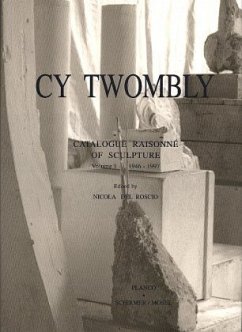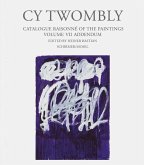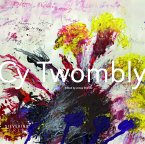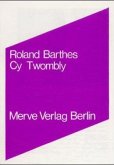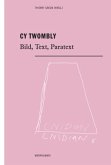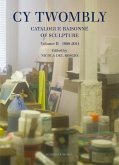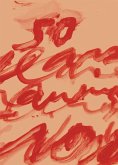Since his large retrospective in New York and Berlin in 1995, if not earlier, Cy Twombly has been known to the general public. In the 50ies Twombly, born in Lexington, Virginia in 1928, broke with his New York companions Jasper Johns and Robert Rauschenberg. Living in the seclusion of a palazzo in Rome since 1957, he has devoted himself to his individual, unconventional art, using the reductionistic language of modern art and yet without any reservations about using the grand gestures of mythology, literature and history. The poetical-mythical components of his painting also feature in his sculptures, which Twombly first released for comprehensive publication in the form of this book. He combines everyday objects such as crates, palm leaves, artificial flowers, nails, door knobs, wooden blocks, willow canes, pieces of string and paper with white painted sculptures: their everyday identity and reality are still apparent, and yet they are simultaneously transferred to a state devoid of time and change. Cy Twomblys sculptures are reminiscent of the hieratical figures in Egyptian or Mesopotamian art that become metaphors of a dimension beyond time and space. Similar to Ovid in his Metamorphoses, Cy Twombly transforms objects, imparting to them a mythical sense: the texture of a palm leaf becomes the flight of a bird in Cycnus; nails and flowers evoke the first flush of dawn or the Russian revolution ship in Aurora. Twomblys sculptures are mythological poems, playful, witty and at times even sarcastic. The introductory essay was written by the American art writer and philosopher, Arthur C. Danto.
Spätestens seit seiner großen Retrospektive in New York und Berlin 1995 ist Cy Twombly auch einer breiteren Öffentlichkeit zum Begriff geworden. In den fünfziger Jahren trennte sich Twombly, 1928 in Lexington/Virginia geboren, von seinen New Yorker Weggefährten Jasper Johns und Robert Rauschenberg und vertiefte sich in der Abgeschiedenheit eines römischen Palazzos, wo er seit 1957 lebt, in seine eigenwillige Kunst, die der reduktionistischen Sprache der Moderne folgt und dennoch die große Geste von Mythologie, Literatur und Geschichte nicht scheut. Das Poetisch-Mythische seiner Malerei findet sich auch in seinen Skulpturen, die wir nun in einer Neuauflage wieder zugänglich machen. Cy Twombly fügt gewöhnliche Gegenstände wie Kisten, Palmblätter, künstliche Blumen, Nägel, Türknöpfe, Holzblöcke, Weidenruten, Schnüre und Papier zu weiß bemalten Skulpturen: Ihre Alltagsidentität und Dinghaftigkeit bleiben in diesen präsent, und doch werden sie gleichzeitig in einen Zustand überführt, der Zeit und Veränderung nicht kennt. Cy Twomblys Skulpturen muten an wie die hieratischen Gestalten der ägyptischen oder mesopotamischen Kunst, die zu Metaphern des Zeit- und Raumlosen werden.Wie Ovid in seinen Metamorphosen transformiert Cy Twombly Objekte in eine mythische Sinnhaftigkeit: Die Struktur eines Palmblattes wird zum Flug eines Vogels in Cycnus, Nagel und Blume evozieren in Aurora die Morgenröte oder das russische Revolutionsschiff. Twomblys Skulpturen sind mythologische Gedichte, verspielt, witzig und manchmal auch sarkastisch. Den einleitenden Essay verfaßte der amerikanische Kunstschriftsteller und Philosoph Arthur C. Danto.
Spätestens seit seiner großen Retrospektive in New York und Berlin 1995 ist Cy Twombly auch einer breiteren Öffentlichkeit zum Begriff geworden. In den fünfziger Jahren trennte sich Twombly, 1928 in Lexington/Virginia geboren, von seinen New Yorker Weggefährten Jasper Johns und Robert Rauschenberg und vertiefte sich in der Abgeschiedenheit eines römischen Palazzos, wo er seit 1957 lebt, in seine eigenwillige Kunst, die der reduktionistischen Sprache der Moderne folgt und dennoch die große Geste von Mythologie, Literatur und Geschichte nicht scheut. Das Poetisch-Mythische seiner Malerei findet sich auch in seinen Skulpturen, die wir nun in einer Neuauflage wieder zugänglich machen. Cy Twombly fügt gewöhnliche Gegenstände wie Kisten, Palmblätter, künstliche Blumen, Nägel, Türknöpfe, Holzblöcke, Weidenruten, Schnüre und Papier zu weiß bemalten Skulpturen: Ihre Alltagsidentität und Dinghaftigkeit bleiben in diesen präsent, und doch werden sie gleichzeitig in einen Zustand überführt, der Zeit und Veränderung nicht kennt. Cy Twomblys Skulpturen muten an wie die hieratischen Gestalten der ägyptischen oder mesopotamischen Kunst, die zu Metaphern des Zeit- und Raumlosen werden.Wie Ovid in seinen Metamorphosen transformiert Cy Twombly Objekte in eine mythische Sinnhaftigkeit: Die Struktur eines Palmblattes wird zum Flug eines Vogels in Cycnus, Nagel und Blume evozieren in Aurora die Morgenröte oder das russische Revolutionsschiff. Twomblys Skulpturen sind mythologische Gedichte, verspielt, witzig und manchmal auch sarkastisch. Den einleitenden Essay verfaßte der amerikanische Kunstschriftsteller und Philosoph Arthur C. Danto.

